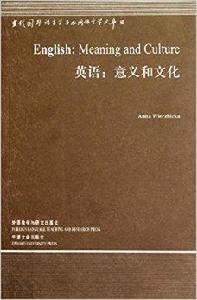基本介紹
內容簡介
《英語:意義和文化》是當代國外語言學與套用語言學文庫
作者簡介
作者:(澳大利亞)威爾斯比克(Anna Wierzbicka)
圖書目錄
Part Ⅰ. Meaning, History and Culture
1. English as a Cultural Universe
1.1. English-the most widely used language in the world
1.2. English and Englishes
1.3. An illustration: Words, scripts, and human lives
1.4. “Anglo English” as a historical formation
1.5. The tendency to mistake “Anglo English” for the human norm
1.6. The cultural underpinnings of (Anglo) English
1.7. A framework for studying and describing meaning
2. Anglo Cultural Scripts Seen through
Middle Eastern Eyes
2.1. Linguistics and intercultural communication
2.z. The theory of cultural scripts
2.3. The Anglo ideal of “accuracy” and the practice of “understatement”
2.4. “To the best of my knowledge...”
2.5. Anglo respect for “facts”
2.6. “Cool reason”:To think vs. to feel
2.7. To compel or not to compel? The value of autonomy
2.8. Conclusion
Part Ⅱ. English Words: From Philosophy to Everyday Discourse
3. The Story of RICGHT and WRONG and Its Cultural Implications
3.1. Introduction
3.2. “Right” and “wrong”: A basis for ethics?
3.3. The link between “right” and “reason”
3.4. “That's right”
3.5. An illustration: English vs. Italian
3.6. “Right” as a neutral ground between “good” and “true”
3.7. Procedural morality
3.8. “Right” and “wrong”: Increasingly asymmetrical
3.9. The changing frequencies of true, truth, right, and wrong
3.10. “Right” as a response in dialogue
3.11. “Right” and cultural scripts
3.22. Retrospect and conclusion: The Puritans, the Enlightenment,the growth of democracy
4. Being REASONABLE: A Key Anglo Value and Its Cultural Roots
4.1. Introduction
4.2. The pre-Enlightenment uses of“reasonable”
4.3. The main themes in the modern meanings of the word reasonable
4.4. “A reasonable man”
4.5. “It is reasonable to” think (say, do)
4.6. “Reasonable doubt”
4.7. “Reasonable force” and “reasonable care”
4.8. “A reasonable time,” “A reasonable amount”
4.9. “Reasonable” as “reasonably good”
4.10. “Reasonable” and “unreasonable”
4.11. An internal reconstruction of the semantic history of “reasonable”
4.12. “Reasonable” and Anglo cultural scripts
4,13. Is the Anglo value of “reasonable” unique? English vs. French
5 Being FaiR: Another Key Anglo Value and Its Cultural Underpinnings
5.1. The importance of “fairness” in modern Anglo culture
5.2. The meaning of fair and not fair
5.3. “Fairness” and Anglo political philosophy
5.4. “Fairness” vs. “justice”
5.5. The illusion of universality
5.6. “Fairness” and “fair play”: A historical perspective
5.7. “Fairness” and “procedural morality”
Part Ⅲ. Anglo Culture Reflected in English Grammar
6. The English Causatives: Causation and Interpersonal Relations
6.1. The cultural elaboration of causation
6.2. The English “let”-constructions and the cultural ideal of “noninterference”
7. 1 THINK: The Rise of Epistemic Phrases in Modern English
7.1. Introduction
7.2. I think
7.3. I suppose
7.4. I guess
7.5. I gather
7.6. I presume
7.7. I believe
7.8. I find
7.9. I expect
7.10. I take It
7.11. I understand
7.12. I imagine
7.13. I bet
7.14. I suspect
7.15. I assume
7.16. Conclusion
8. PROBABLY: English Epistemic Adverbs and Their Cultural Significance
8.1. Introduction
8.2. Developing a format for the semantic analysis of epistemic adverbs
8.3. “Probably” and “likely”: The heart of the category of epistemic adverbs
8.4. “Confident” adverbs: Evidently, clearly, obviously
8.5. “Nonconfident” adverbs: Possibly and conceivably
8.6. Hearsay adverbs: Apparently, supposedly, allegedly,and reportedly
8.7. The “uncertain” status of certainly
8.8. Epistemic adverbs vs. discourse particles
8.9. The history of epistemic adverbs in modern english
Part Ⅳ. Conclusion
9. The “Cultural Baggage” of English and Its Significance in the World at Large
9.1. The legacy of history
9.2. Living with concepts
9.3. Two illustrations: International law and international aviation
9.4. Communication and “vibes”
9.5. Intercultural communication and cross-cultural education
9.6. English in the world today
Notes
References
Index
文摘
In her memoir New York (zoox), the Australian writer Lily Brett (who was raisedin Australia) writes: "Some untruths are essential. For example, compliments thatare not entirely accurate, and other forms of kindness or flattery. Sometimes it doesn'tmake sense to tell the truth. Sometimes it would be just plain stupid" . Brett contrasts these cultural assumptions, which she accepts, with those of her father——aPolish Jewish Holocaust survivor, of whom she says that "he is fond of the truth."Present at an interview given by his daughter, the father embarrasses her by inter-rupting and contradicting what she has said. Brett writes: "I couldn't believe it. 'Itdidn't happen the way you said it did,' my father said. I didn't want to start a familyargu ment in front of the journalist. I glared at my father. He deflected my glare. 'The truth is the truth,' he declared" (p. 84). This saying corresponds to the Polish expres-sion "co prawda to prawda" (lit. "what truth that truth"), which may have been at theback of her father's mind; from a contemporary Anglo perspective, however, it seemstoo inflexible and too absolute: "facts" are "facts" (because facts are "plain," "simple,"and "hard"), but "truth" is no longer simply "truth."

